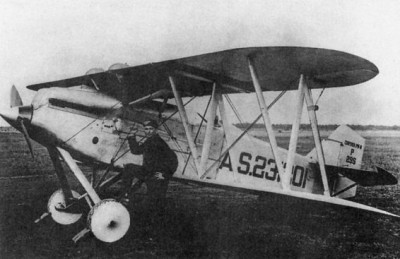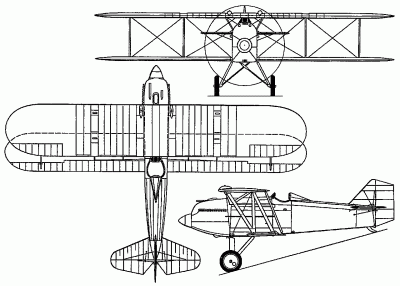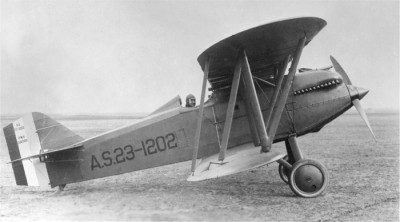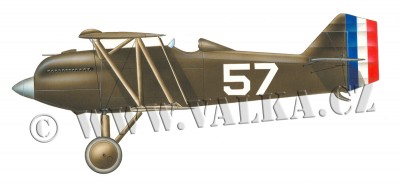| Název: Name: | Curtiss PW-8 | Curtiss PW-8 |
| Originální název: Original Name: | Curtiss PW-8 | |
| Kategorie: Category: | stíhací letoun | fighter aeroplane |
| Výrobce: Producer: | DD.MM.1924-DD.MM.192R Curtiss Aeroplane & Motor Co., Buffalo, New York | |
| Období výroby: Production Period: | DD.MM.1924-DD.MM.192R | |
| Vyrobeno kusů: Number of Produced: | 2 XPW-8 (23-1201/23-1202) 25 PW-8 (24-201/24-225) | |
| První vzlet: Maiden Flight: | DD.01.1923 XPW-8 | |
| Osádka: Crew: | 1 | |
| Základní charakteristika: Basic Characteristics: | ||
| Vzlet a přistání: Take-off and Landing: | CTOL - konvenční vzlet a přistání | CTOL - conventional take-off and landing |
| Uspořádání křídla: Arrangement of Wing: | dvouplošník | biplane |
| Uspořádání letounu: Aircraft Concept: | klasické | conventional |
| Podvozek: Undercarriage: | pevný | fixed |
| Přistávací zařízení: Landing Gear: | kola | wheels |
| Technické údaje: Technical Data: | ||
| Hmotnost prázdného letounu: Empty Weight: | 991 kg | 2185 lb |
| Vzletová hmotnost: Take-off Weight: | 1431 kg | 3155 lb |
| Maximální vzletová hmotnost: Maximum Take-off Weight: | ? kg | ? lb |
| Rozpětí: Wingspan: | 9.75 m | 32ft |
| Délka: Length: | 7.04 m | 23ft 1in |
| Výška: Height: | 2.77 m | 9ft 1in |
| Plocha křídla: Wing Area: | 25.95 m2 | 279,3 ft2 |
| Plošné zatížení: Wing Loading: | ? kg/m2 | ? lb/ft2 |
| Pohon: Propulsion: | ||
| Kategorie: Category: | pístový | piston |
| Počet motorů: Number of Engines: | 1 | |
| Typ: Type: | Curtiss D-12 o výkonu 313 kW dvoulistá vrtule | Curtiss D-12, power 420 hp two-blade propeller |
| Objem palivových nádrží: Fuel Tank Capacity: | 284 l | 75 US gal |
| Výkony: Performance: | ||
| Maximální rychlost: Maximum Speed: | 275.2 km/h v 0 m | 171 mph in 0 ft |
| Cestovní rychlost: Cruise Speed: | 218.9 km/h v 0 m | mph in ft |
| Rychlost stoupání: Climb Rate: | 9.3 m/s | 1830 ft/min |
| Čas výstupu na výšku: Time to Climb to: | ? min do ? m | ? min to ? ft |
| Operační dostup: Service Ceiling: | 6203 m | 20350 ft |
| Dolet: Range: | 875.5 km | 544 mi |
| Maximální dolet: Maximum Range: | ? km | ? mi |
| Výzbroj: Armament: | 2x 7,62mm kulomet | 2x .30 machine gun |
| Uživatelské státy: User States: | | |
| Poznámka: Note: | - | - |
| Zdroje: Sources: | Bowers, P. M. Curtiss Aircraft 1907-1947, Putnam Aeronautical Books, London 1979. ISBN 0-370-10029-8. Bowers, P. M. Curtiss Army Hawks, Aircraft in Profile No.45. Profile Publications, Leatherhead 1965. United States Army and Air Force Fighters 1916-1961, Harleyford Publications, Letchworth 1961. Fahey, James C. U.S. Army Aircraft 1908-1946. Ships and Aircraft, Falls Church, 1964. Bowers, P. M. Forgotten Fighters/2 and Experimental Aircraft U.S. Army 1918-1941, Arco Publishing Company, New York 1971. ISBN 0-66802-403-8. www.americancombatplanes.com www.shu-aero.com http://www.aviastar.org/air/usa/curtiss_pw-8.php http://crimso.msk.ru/Site/Crafts/Craft31032.htm http://joebaugher.com/usaf_fighters/p1.html | |
| Period | - |
| Producer | Curtiss |
| Type | Curtiss PW-8 |
| Camouflage | Civilní |
| Country |  |
| Pilot | - |
| Production No. | - |
| Serial No. / Evidence No. | 23-201 |
| Tactical Marking / Imatriculation | - |
| Name | - |
| Unit | - |
| Base | - |
| Date (DD.MM.RRRR) | - |
| Author | - |
| Print size / 300 DPI | - |
| Published with authors permit | - |
| Author Website | - |
První XPW-8 si ponechal civilní kamufláž, i když dostal armádní serial na trup. Na snímku s poručíkem Maughanem, držitelem rychlostních rekordů z října 1922 a března 1923, dosažených na Curtissu R-6.
| Period | - |
| Producer | - |
| Type | Curtiss PW-8 |
| Camouflage | - |
| Country | - |
| Pilot | - |
| Production No. | - |
| Serial No. / Evidence No. | - |
| Tactical Marking / Imatriculation | - |
| Name | - |
| Unit | - |
| Base | - |
| Date (DD.MM.RRRR) | - |
| Author | - |
| Print size / 300 DPI | - |
| Published with authors permit | - |
| Author Website | - |



 Olivově zelená / Olive Green
Olivově zelená / Olive Green
